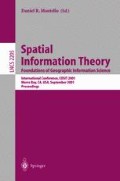Abstract
Linguistic research to date has determined many of the factors that structure the spatial schemas found across spoken languages. It is now feasible to integrate these factors and to determined the comprehensive system they constitute for spatial structuring in spoken language. This system is characterized by several features: It has a relatively closed universally available inventory of fundamental spatial elements that are combined to form whole schemas. It has a relatively closed set of categories that these elements appear in. And it has a relatively closed small number of particular elements in each category, hence, of spatial distinctions that each category can ever mark. An examination of signed language shows that its structural representation of space systematically differes from that in spoken language in the direction of what appear to be the structural characteristics of scene parsing in visual perception. Such differences include the following: Signed language can mark finer spatial distinctions with its inventory of more structural elements, more categories, and more elements per category. It represent these distinctions independently in the expression, not bundled together into “pre-packaged” schemas. And its spatial representations are largely iconic with visible spatial characteristics. The findings suggest that instead of some discrete whole-language module, spoken language and signed language are both based on some more limited core linguistic system that then connects with different further subsystems for the full funtioning of the two different language modalities.
Access this chapter
Tax calculation will be finalised at checkout
Purchases are for personal use only
Preview
Unable to display preview. Download preview PDF.
References
Bennett, David C. 1975. Spatial and temporal uses of English prepositions: An essay in stratificational semantics. London: Longman.
Clark, Herb, 1973. Space, time, semantics, and the child. In Timothy E. Moore (ed.) Cognitive development and the acquisition of language. New York: Academic Press.
Emmorcy, Karen. In Press. Language, cognitions and the brain: Insights from sign language research. Lawrence Erlbaum.
Fillmore, Charles. 1968. The case for case. In Emmon Bach & Robert T. Harms (eds.) Universals in linguistic theory. New York: Holt, Rinehart and Winston.
Gruber, Jeffrey S. 1965. Studies in lexical relations. PhD dissertation, MIT. Reprinted as part of Lexical structures in syntax and semantics, 1976. Amsterdam: North-Holland.
Herskovits, Annette. 1982. Space and the prepositions in English: Regularities and irregularities in a complex domain. PhD dissertation, Stanford University.
Jackendoff, Ray. 1983. Semantics and cognition. Cambridge, MA: MIT Press.
Leech, Geoffrey. 1969. Towards a semantic description of English. New York: Longman Press, 1969.
Liddell, Scott. Forthcoming. Sources of meaning in ASL classifier predicates. In Karen Emmorey (ed.) Perspectives on classifier constructions in signed languages (provisional title). Likely publisher: Cambridge University Press.
Talmy, Leonard. 1983. How language structures space. In Herbert L. Pick, Jr. & Linda P. Acredolo (eds.) Spatial orientation: Theory, research, and application. New York: Plenum Press.
—. 2000a. Toward a cognitive semantics, volume I: Concept structuring systems. Cambridge, MA: MIT Press.
—. 2000b. Toward a cognitive semantics, volume II: Typology and process in concept structuring. Cambridge, MA: MIT Press.
—. Forthcoming. Spatial Structuring in Spoken and Signed Language. In Proceedings of the Berkeley Linguistics Society, 2001.
Zubin, David & Soteria Svorou. 1984. Orientation and gestalt: conceptual organizing principles in the lexicalization of space. With S. Choi. In David Testen, Veena Mishra & Joseph Drogo. Lexical semantics. Chicago: Chicago Linguistic Society.
Author information
Authors and Affiliations
Editor information
Editors and Affiliations
Rights and permissions
Copyright information
© 2001 Springer-Verlag Berlin Heidelberg
About this paper
Cite this paper
Talmy, L. (2001). How Spoken Language and Signed Language Structure Space Differently. In: Montello, D.R. (eds) Spatial Information Theory. COSIT 2001. Lecture Notes in Computer Science, vol 2205. Springer, Berlin, Heidelberg. https://doi.org/10.1007/3-540-45424-1_17
Download citation
DOI: https://doi.org/10.1007/3-540-45424-1_17
Published:
Publisher Name: Springer, Berlin, Heidelberg
Print ISBN: 978-3-540-42613-4
Online ISBN: 978-3-540-45424-3
eBook Packages: Springer Book Archive

